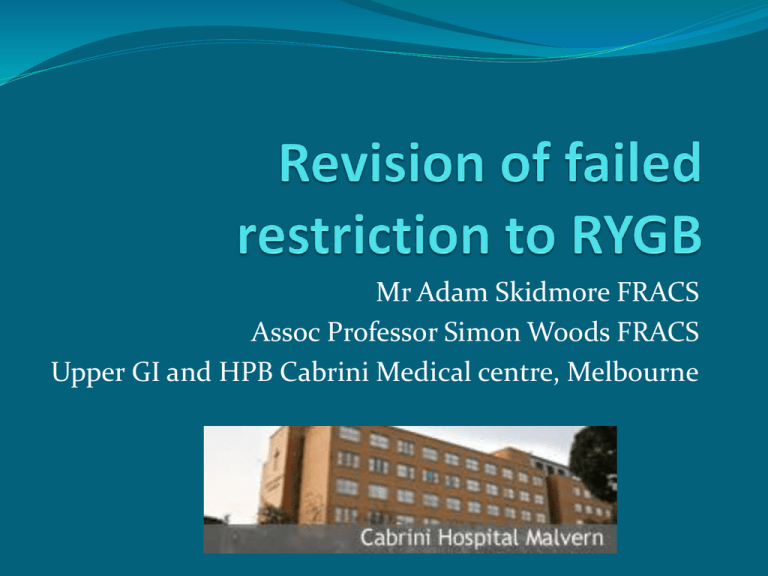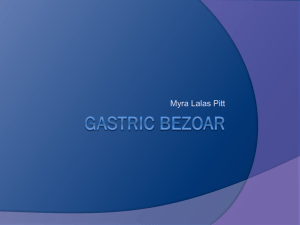Revision of failed restriction to RYGB
advertisement

Mr Adam Skidmore FRACS Assoc Professor Sim0n Woods FRACS Upper GI and HPB Cabrini Medical centre, Melbourne Introduction Look at 29 patients who have had either a failed Gastric Band – adjustable and fixed , VBG/HGR or Jejuno-ileal bypass Failure was either weight regain/non weight loss Technical failure of the original operation Other issues – gastroparesis, reflux and vomiting Techniques for revision Results of our experience Sometimes surgery doesn't work Revision is an option 2 surgeon series 29 cases of conversion of HGR/VBG, Gastric Band or jejuno-ileal bypass to RYGB Experienced in RYGB – open and Laparoscopic Gastric Band Failure Defined as either no weight loss at all or weight loss of less than 10% EW Variety of reasons Maladaptive eating behavior Technical issues with the band Recurrent slip Dilation of the pouch Failure of VBG/HGR Late failures - most 10years + Maladaptive eating behaviour Dilatation of the pouch – weight regain or reflux Staple line dehiscence – weight regain Reversal of stapling Encouraged to reverse if severe maladaptive eating Reversal is by removal of the sutures 6 months of normal diet and exercise prior to reversal Methods of revision All patients are fully evaluated by a multidisciplinary team Often have seen a Nutritional physician Gastroscopy Barium series At least 2 pre operative consults with the surgeon 2 weeks of optifast BMI <50 4 weeks of optifast BMI>50 Slipped band Dilated pouch with stenosis Large hiatal hernia Roux En Y Gastric Bypass Preferred method of revision Open approach Often multiple previous surgeries Midline laparotomy Laparoscopic staplers/seamguard Upper GI omnitract Handsewn Gastrojejunostomy or orvil 25mm circular stapler Handsewn enteroenterostomy Bariatric omnitract Results 29 patients Range of previous surgeries Often multiple operations - open and laparoscopic Mostly failure of weight loss Significant amount of failures related to technical issues All successful completion to RYGB 3 underwent a partial gastric resection 2 underwent a partial liver resection Results Limited by follow up of 2-18 months Average weight – 121 kg 170kg – 80 kg 20 females and 9 males Weight loss average – 60% EW excluding patients <6months All had resolution of gastroparesis Significant improvement in diabetes All had resolution of reflux and vomiting Complications Leak – 2 gastrojejunostomy leaks Bile leak – 1 bile leak treated by percutaneous drain Wound infection – 2 wound infections requiring AB and 1 requiring VAC dressing Incisional hernia and internal herniation – 5 incisional hernias and 1 internal hernia LOS and return to work Average LOS – 5 days Return to work – 3.5 weeks TAKES AT LEAST 3 MONTHS TO RETURN TO PREOPERATIVE QUALITY OF LIFE Tips and pitfalls - stapling Important to determine if stapling is dehisced or if large pouch If large pouch – must stay within the staple line – risk of ischaemia Sometimes better to perform a fundectomy excising the fundus and staple line – easier to enter the lesser sac away from adhesions Fundectomy/mini sleeve can minimize splenic injury Gastric band If there is slippage – REMOVE THE BAND AND WAIT If no slippage it is safe to perform in one surgery – MUST REMOVE THE CAPSULE AND ALL SUTURES GREEN LOADS +/- SEAMGUARD Difficult Left lobe of Liver Bleeding Adhesions Can remove part of the left lobe safely with the echilon stapler Less bleeding Less Bile leak Post operative NGT – 24 hours Gastrograffin swallow 24-48 hrs Fluids after confirmation of no leak Jackson pratt drain for 5 days In very large patients useful to drain the subcutaneous space Vac dressings can be useful in very large patients with wound infection conclusions Technically challenging Access to ICU and Interventional radiology Multidisciplinary support Results can be as good as primary RYGB Morbidity is higher











